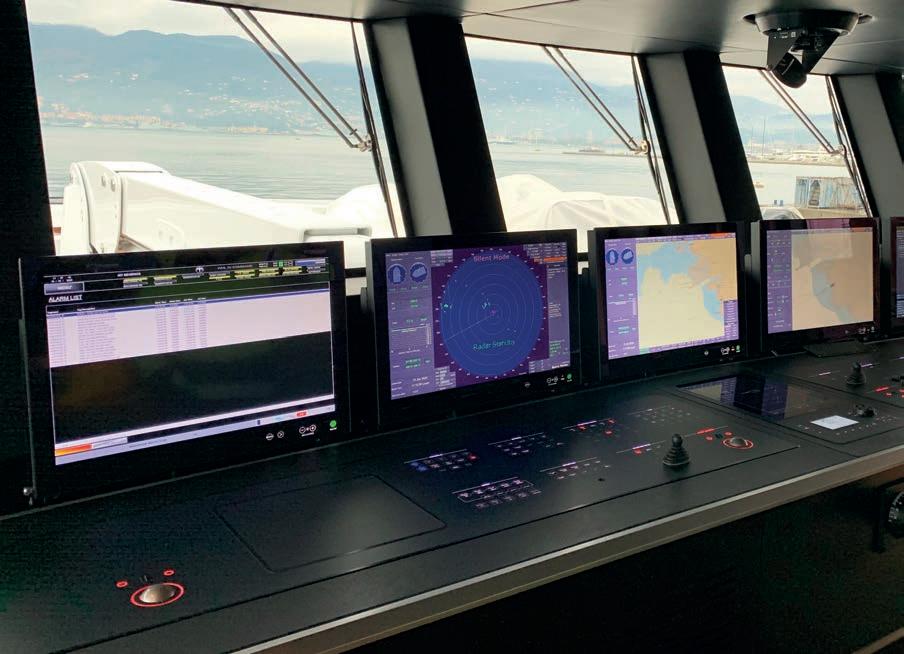
4 minute read
Innovation can build a bridge to digitalisation
A TRULY INNOVATIVE BUSINESS IS ONE THAT CAN ANTICIPATE ITS CUSTOMER’S DESIRES WHILE ALSO PROVIDING FOR THEIR NEEDS. IF THAT SOUNDS LIKE A CONTRADICTION, THEN IT ONLY SERVES TO ILLUSTRATE THE CHALLENGE THAT MANY BUSINESSES FACE IN ADAPTING to the era of rapid digitalisation. Being able to marry these competing demands requires the ability to adapt a, sometimes traditional business-to-business mindset to a market where the speed of technology adoption can outstrip product development cycles.
WORDS BY JAMES COLLETT, MANAGING DIRECTOR OF SPERRY MARINE. ALL PHOTOS COURTESY OF SPERRY MARINE.
Sperry Marine and long-time partner Telemar Yachting cooperated on the design, delivery, and installation of a complete integrated bridge onboard the superyacht Severin, built by Baglietto, Italy.
James Collett, Managing Director of Sperry Marine.

Aesthetics vs. type approval
The evolution of superyacht bridge design has been driven by increasing requests from designers for systems that combine a very strong aesthetic quality with the type approval that provides high levels of safety and reliability. It is even more true when the area of operation is not concerned with fuel savings or schedule keeping, but the regulated safety space on the bridge. The requirement for type approved standards-based systems for navigation safety is a far cry from an app-based effciency gain or drone-based spare parts delivery. As a company that has navigation systems in its DNA, it has become a natural extension for us to think about what digitalisation can do for our customers, since more and more of them are working to combine enhanced functionality with improved connectivity from bridge to shore.
Safety frst
Every superyacht bridge is bespoke and no two are the same, yet superyachts are fully ocean-going vessels, so safety is a priority. A type-approved bridge system must provide the look and feel that owners demand, but also the redundancy and backup that the vessel needs. Sperry Marine’s technology is trusted by navies and merchant shipping world-wide, but there is little to match the demanding constraints on space and ventilation for a superyacht bridge that still meets the owner’s requirements for a slick appearance. There are several elements to innovation on the bridge, of which the frst centre around gathering data to analyse system performance, better plan servicing and maintenance of the bridge components. Digital updates for the electronic chart display are already happening, but there is a need to improve the procedure for getting the data into the front of the bridge navigation system. Rather than relying on USB fash drives for transfer, there should be an independently hosted back of the bridge system with a secure connection to the front of the bridge system. The data-on-demand model is quickly being replaced by real-time monitoring of vessel systems, and customers are already exploring the benefts of a richer data stream that can enhance safety and effciency of bridge operations.
Customers decide
We also employ the same secure data stream to deploy software updates and patches directly into the bridge system, whether the vessel is alongside or on voyage. This data can also be used to deliver more data from shore such as weather updates, safe routing or berth availability. These changes are already taking place, however we think that customers, rather than vendors, should decide how and at what speed such tools – as well as more advanced ones – should be applied. This new era requires that the supplier changes as well and builds a new skills base with employees experienced in connectivity and data, so that the outcome is an improvement and not a further complication to an already complex business.
Layered cyber security strategy
We are also aware that with greater connectivity and increased data transfer comes an increased security risk which must be managed. Our approach is to build a cyber infrastructure that can maintain more than just an ‘air gap’ between the ship’s network and the front of the bridge navigation system to provide a robust physical component of a layered cyber security strategy. This approach to innovation could be viewed as small steps in the right direction, but it is critical that the strategy actually provides tangible results, instead of innovations in search of a business model. By building a platform that can be used to deliver services as well as systems, we will be able to make giant leaps too. It also refects the fact that – whenever possible – our service engineers are present on the vessel. This will allow us to see how customers use our products and hear frst-hand about the improvements and enhancements they want to see. That gives us a unique perspective on how to create new services that meet these changing needs.
A new approach
For a company that has been the go-to for radar, ECDIS, gyrocompass, and autopilot – and that always left operations to the captain – this is a completely new approach. History and heritage are not enough to protect any company from the challenges of digitalisation, but change does not need to be a threat to survival. Instead, it enables a much closer dialogue on how we can support customer operations and deliver real digital value, rather than create disruption for its own sake.










